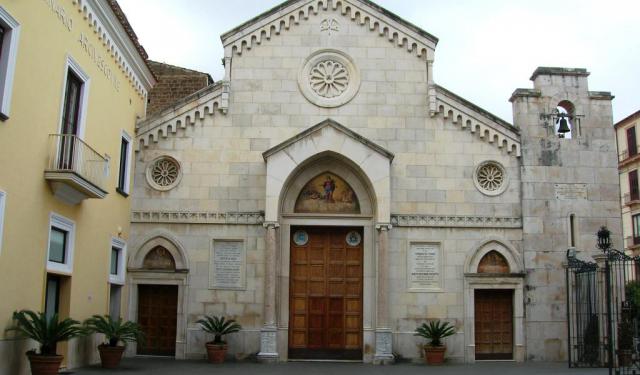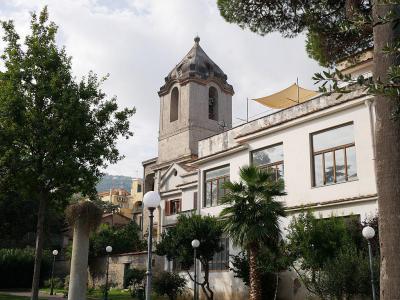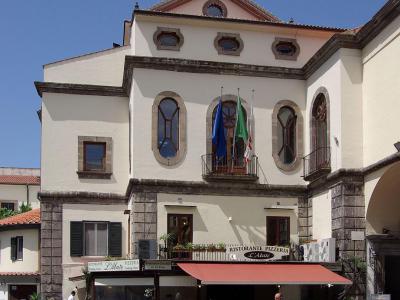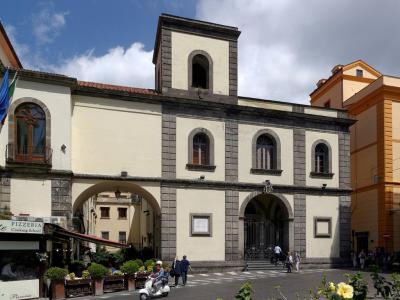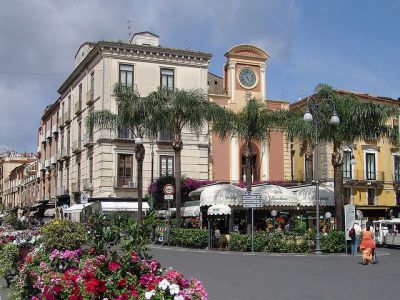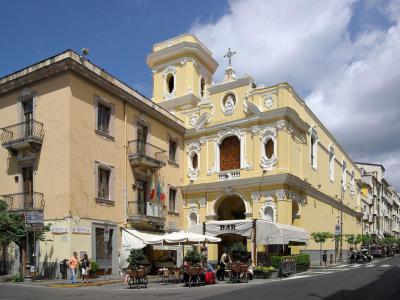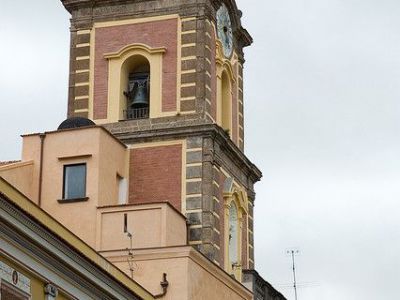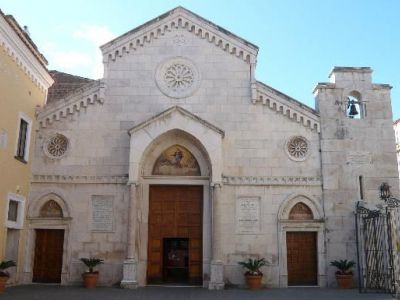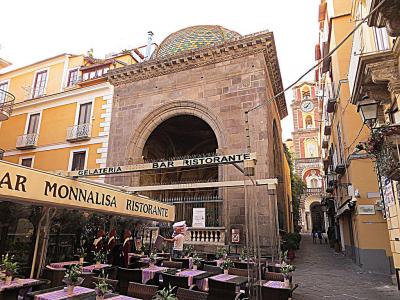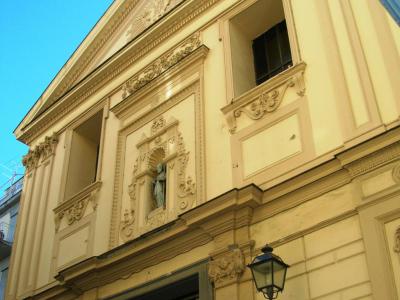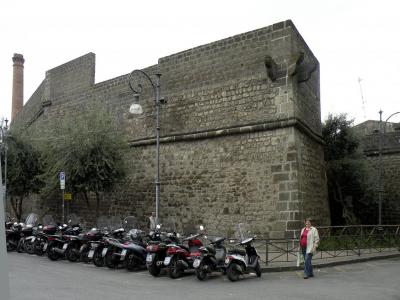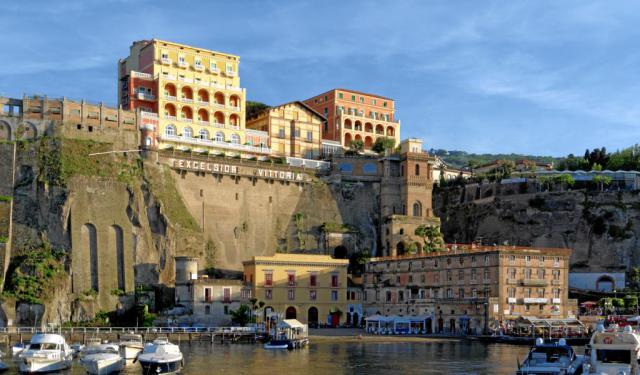Sorrento's Historical Buildings Walking Tour (Self Guided), Sorrento
Much like many other places in Italy, the charming coastal town of Sorrento has no shortage of cultural heritage. The influence of different historical periods is seen particularly well in the center of the town, where a number of notable buildings have proudly withstood the test of time. Among these are several beautiful churches and monasteries that still keep some of Sorrento's valuable memories alive.
One such is the Church and Cloister of Saint Francis (Chiostro di San Francesco). This peaceful complex showcases elegant design and serves as a tranquil retreat.
The 16th-century Tasso Theater (Teatro Tasso), another architectural gem, has seen its share of shows over the years. Its cultural significance makes it a draw for theater enthusiasts.
The Church of Saint Antonino (Chiesa di Sant'Antonino) stands as a testament to the town's religious heritage. Its noble facade and intricate interior create a serene atmosphere for visitors.
The Gate Door Seat (Sedile di Porta), in turn, reflects the communal spirit of Sorrento as a meeting place for the town's elders and a hub for public discussions. The Dominova Seat (Sedile Dominova) is another gathering place that echoes the town's history and social connections.
The Church of Carmine showcases magnificent religious artistry and is vital to the local religious community. Similarly, the Sorrento Cathedral (Cattedrale di Sorrento) is a monument of architecture and spirituality, whose grandeur and religious significance make it a cherished landmark.
Meanwhile, the Cathedral’s Bell Tower stands tall as an iconic symbol of the town's skyline. At the same time, the Church of Rosary (Chiesa Del Rosario) is a place of worship and artistic beauty, capturing the essence of Sorrento's culture.
Finally, the Ancient Walls and Parsano Bastion serve as reminders of Sorrento's historical fortifications and strategic significance.
For a deeper understanding of Sorrento's past and its enduring traditions, we invite you to explore these remarkable landmarks. Each building has its own story to tell, and by visiting them, you'll not only enrich your knowledge but also contribute to the preservation of these historical treasures for future generations to enjoy.
One such is the Church and Cloister of Saint Francis (Chiostro di San Francesco). This peaceful complex showcases elegant design and serves as a tranquil retreat.
The 16th-century Tasso Theater (Teatro Tasso), another architectural gem, has seen its share of shows over the years. Its cultural significance makes it a draw for theater enthusiasts.
The Church of Saint Antonino (Chiesa di Sant'Antonino) stands as a testament to the town's religious heritage. Its noble facade and intricate interior create a serene atmosphere for visitors.
The Gate Door Seat (Sedile di Porta), in turn, reflects the communal spirit of Sorrento as a meeting place for the town's elders and a hub for public discussions. The Dominova Seat (Sedile Dominova) is another gathering place that echoes the town's history and social connections.
The Church of Carmine showcases magnificent religious artistry and is vital to the local religious community. Similarly, the Sorrento Cathedral (Cattedrale di Sorrento) is a monument of architecture and spirituality, whose grandeur and religious significance make it a cherished landmark.
Meanwhile, the Cathedral’s Bell Tower stands tall as an iconic symbol of the town's skyline. At the same time, the Church of Rosary (Chiesa Del Rosario) is a place of worship and artistic beauty, capturing the essence of Sorrento's culture.
Finally, the Ancient Walls and Parsano Bastion serve as reminders of Sorrento's historical fortifications and strategic significance.
For a deeper understanding of Sorrento's past and its enduring traditions, we invite you to explore these remarkable landmarks. Each building has its own story to tell, and by visiting them, you'll not only enrich your knowledge but also contribute to the preservation of these historical treasures for future generations to enjoy.
How it works: Download the app "GPSmyCity: Walks in 1K+ Cities" from Apple App Store or Google Play Store to your mobile phone or tablet. The app turns your mobile device into a personal tour guide and its built-in GPS navigation functions guide you from one tour stop to next. The app works offline, so no data plan is needed when traveling abroad.
Sorrento's Historical Buildings Walking Tour Map
Guide Name: Sorrento's Historical Buildings Walking Tour
Guide Location: Italy » Sorrento (See other walking tours in Sorrento)
Guide Type: Self-guided Walking Tour (Sightseeing)
# of Attractions: 10
Tour Duration: 1 Hour(s)
Travel Distance: 1.2 Km or 0.7 Miles
Author: Linda
Sight(s) Featured in This Guide:
Guide Location: Italy » Sorrento (See other walking tours in Sorrento)
Guide Type: Self-guided Walking Tour (Sightseeing)
# of Attractions: 10
Tour Duration: 1 Hour(s)
Travel Distance: 1.2 Km or 0.7 Miles
Author: Linda
Sight(s) Featured in This Guide:
- Chiostro di San Francesco (Church and Cloister of Saint Francis)
- Teatro Tasso (Tasso Theater)
- Chiesa di Sant'Antonino (Church of Saint Antonino)
- Sedile di Porta (Gate Door Seat)
- Church of Carmine
- The Cathedral’s Bell Tower
- Cattedrale di Sorrento (Sorrento Cathedral)
- Sedile Dominova (Dominova Seat)
- Chiesa Del Rosario (Church of the Rosary)
- Ancient Walls and Parsano Bastion
1) Chiostro di San Francesco (Church and Cloister of Saint Francis) (must see)
The Church and Cloister of Saint Francis are near the public gardens of Sorrento, with stunning views of the fabled Gulf of Naples. The church was built in the 8th century. Originally it was an oratory founded by Saint Antonino, dedicated to Saint Martin of Tours, and reconstructed in the Baroque style by the Franciscans in the 14th century.
The church has a simple white facade divided into two parts. The well-preserved 14th-century portal is flanked by five pilasters, on each side, on the lower part. There are two arched blind windows on either side of the portal. In the left window is a painting of Saint Francis. A similar portrait of Saint Antonino appears on the right.
The upper part of the facade has a mullioned rose window flanked by two pilasters on each side. A scalloped roof front surmounts the crenelated edges of the upper side.
The church has one nave and six chapels. On the right facing the altar, in the first two chapels, are the statues of Saint Francis and Saint Antonino. On the left, we find the statues of Saint Rita of Cascia and the Immaculate Madonna. Above the altar is a 1735 painting Saint Francis Receiving the Stigmata.
In the sacristy are several marble artifacts from different eras. In the reception hall, it is a 16-century painting of Madonna and Infant with Saint Michael and John the Baptist.
Next to the church is the monastery cloister of Saint Francis. The cloister was founded in the 7th century but ceded to the Franciscans in the 14th century. It presents a mixture of architectural styles. Two sides of the porch have crossed 14th-century tuff arches. Two other sides have rounded arches on octagonal columns.
Architectural artifacts extracted from ancient temples and buildings have been integrated into the construction of the cloister. The cloister is often used for art exhibitions and musical events. It is also a popular venue for weddings.
The church has a simple white facade divided into two parts. The well-preserved 14th-century portal is flanked by five pilasters, on each side, on the lower part. There are two arched blind windows on either side of the portal. In the left window is a painting of Saint Francis. A similar portrait of Saint Antonino appears on the right.
The upper part of the facade has a mullioned rose window flanked by two pilasters on each side. A scalloped roof front surmounts the crenelated edges of the upper side.
The church has one nave and six chapels. On the right facing the altar, in the first two chapels, are the statues of Saint Francis and Saint Antonino. On the left, we find the statues of Saint Rita of Cascia and the Immaculate Madonna. Above the altar is a 1735 painting Saint Francis Receiving the Stigmata.
In the sacristy are several marble artifacts from different eras. In the reception hall, it is a 16-century painting of Madonna and Infant with Saint Michael and John the Baptist.
Next to the church is the monastery cloister of Saint Francis. The cloister was founded in the 7th century but ceded to the Franciscans in the 14th century. It presents a mixture of architectural styles. Two sides of the porch have crossed 14th-century tuff arches. Two other sides have rounded arches on octagonal columns.
Architectural artifacts extracted from ancient temples and buildings have been integrated into the construction of the cloister. The cloister is often used for art exhibitions and musical events. It is also a popular venue for weddings.
2) Teatro Tasso (Tasso Theater)
Tasso Theater (Teatro Tasso) is an ancient theater steeped in history and artistry. Dating back to the 16th century, this theater has weathered the passage of time, enduring a decade-long closure only to emerge anew through meticulous reconstruction efforts. Despite its hiatus, the theater has retained its original architectural charm while adapting to modern audiences' needs.
Establishing its cultural importance in 1920 with the inaugural performances on the peninsula, Tasso Theater has since become a cornerstone of the local arts scene. Today, it is celebrated for its diverse range of musical shows catering to varied tastes, spanning from light opera to jazz.
Originally serving as a convent for the Theatines religious order, the theater underwent a significant transformation in the 1920s, transitioning into a cinema before evolving into the dynamic performance space it is today. It is especially renowned for showcasing local folklore, providing a platform for the region's cultural traditions to thrive.
Among its notable offerings is the Sorrento Amarcord show, a captivating celebration of Neapolitan folk music, dance, and stories. Featuring traditional songs and dances like the tarantella, the show invites audience participation, creating an immersive experience that resonates with the essence of Neapolitan culture.
Tasso Theater not only preserves Sorrento's historical legacy but also serves as a vibrant hub where the arts flourish, bridging the past and present through the universal language of performance.
Establishing its cultural importance in 1920 with the inaugural performances on the peninsula, Tasso Theater has since become a cornerstone of the local arts scene. Today, it is celebrated for its diverse range of musical shows catering to varied tastes, spanning from light opera to jazz.
Originally serving as a convent for the Theatines religious order, the theater underwent a significant transformation in the 1920s, transitioning into a cinema before evolving into the dynamic performance space it is today. It is especially renowned for showcasing local folklore, providing a platform for the region's cultural traditions to thrive.
Among its notable offerings is the Sorrento Amarcord show, a captivating celebration of Neapolitan folk music, dance, and stories. Featuring traditional songs and dances like the tarantella, the show invites audience participation, creating an immersive experience that resonates with the essence of Neapolitan culture.
Tasso Theater not only preserves Sorrento's historical legacy but also serves as a vibrant hub where the arts flourish, bridging the past and present through the universal language of performance.
3) Chiesa di Sant'Antonino (Church of Saint Antonino) (must see)
Leaving Tasso Square, walk along De Maio Street. Shortly, you will arrive at Saint Antonino Square. The Church of Saint Antonino will be on the right. Saint Antonino is the patron saint of Sorrento. He came to Sorrento in the 6th century, seeking refuge from the Lombard invasions of Italy.
One day a whale came up to the beach at Sorrento and swallowed a boy. Antonino got the boy out, safe and sound. Saint Antonino is credited with this and other miracles. He is the patron saint of shipwrecked seafarers. At the entrance to the church is a set of whale bones to memorialize the miracle of the boy meeting the whale.
The Church of Saint Antonino, constructed in the 11th century, stands over a 7th-century oratory built to cover the bones of Saint Antonino. The grey tuff facade features a Romanesque architectural style dating from the 18th century. Three naves were divided by twelve Corinthian-style columns salvaged from ancient Greek and Roman buildings.
At the time of his death, the story goes, Saint Antonino said he did not wish to be buried within or without the city. So, he was put to rest between the walls. In the crypt is a life-like statue of the saint. On one wall are paintings of ships at sea. On another wall are silver talismans of believers saved by Saint Antonino's grace.
One day a whale came up to the beach at Sorrento and swallowed a boy. Antonino got the boy out, safe and sound. Saint Antonino is credited with this and other miracles. He is the patron saint of shipwrecked seafarers. At the entrance to the church is a set of whale bones to memorialize the miracle of the boy meeting the whale.
The Church of Saint Antonino, constructed in the 11th century, stands over a 7th-century oratory built to cover the bones of Saint Antonino. The grey tuff facade features a Romanesque architectural style dating from the 18th century. Three naves were divided by twelve Corinthian-style columns salvaged from ancient Greek and Roman buildings.
At the time of his death, the story goes, Saint Antonino said he did not wish to be buried within or without the city. So, he was put to rest between the walls. In the crypt is a life-like statue of the saint. On one wall are paintings of ships at sea. On another wall are silver talismans of believers saved by Saint Antonino's grace.
4) Sedile di Porta (Gate Door Seat)
The Sedile di Porta, also known as the Gate Door Seat, in Sorrento, represents the rich history of the town, blending centuries of tradition, governance, and architecture. Situated at the center of Tasso Square (Piazza Tasso) and San Cesario Street, it symbolizes Sorrento's seamless integration of past and present.
Originally, during medieval times, the Gate Door Seat served as an important meeting point for the town's noble citizens, being close to Sorrento's main gate, the "Porta." It hosted noble assemblies and played a significant role in local governance. Its emblem, showing a door with three keys on a gold background, represents its historical function as a meeting place for the nobility.
In the 16th century, the Gate Door Seat was a focal point of Sorrento's political life, as evidenced by a plaque in the Tasso Square, highlighting the gatherings of noble families and their influence on town affairs. However, over time, its function changed. After violent disputes in 1319, some families left to establish a new assembly seat, leading to the creation of Dominova along San Cesario Street.
Despite undergoing restorations in the 17th and 18th centuries funded by nobles, the Gate Door Seat saw significant transformations. With the cessation of noble seats in 1800, it became a prison, then a guard post, and later a private club, the Circolo Sorrentino, adding to its historical significance.
Today, the original appearance of the Gate Door Seat has changed, with only a round arch supported by piperno columns along Via San Cesareo remaining recognizable. However, architectural details such as a clock from 1882 on the facade facing Tasso Square and a preserved painting in the church of the Servi di Maria offer glimpses into its past, allowing visitors to connect with Sorrento's heritage.
Originally, during medieval times, the Gate Door Seat served as an important meeting point for the town's noble citizens, being close to Sorrento's main gate, the "Porta." It hosted noble assemblies and played a significant role in local governance. Its emblem, showing a door with three keys on a gold background, represents its historical function as a meeting place for the nobility.
In the 16th century, the Gate Door Seat was a focal point of Sorrento's political life, as evidenced by a plaque in the Tasso Square, highlighting the gatherings of noble families and their influence on town affairs. However, over time, its function changed. After violent disputes in 1319, some families left to establish a new assembly seat, leading to the creation of Dominova along San Cesario Street.
Despite undergoing restorations in the 17th and 18th centuries funded by nobles, the Gate Door Seat saw significant transformations. With the cessation of noble seats in 1800, it became a prison, then a guard post, and later a private club, the Circolo Sorrentino, adding to its historical significance.
Today, the original appearance of the Gate Door Seat has changed, with only a round arch supported by piperno columns along Via San Cesareo remaining recognizable. However, architectural details such as a clock from 1882 on the facade facing Tasso Square and a preserved painting in the church of the Servi di Maria offer glimpses into its past, allowing visitors to connect with Sorrento's heritage.
5) Church of Carmine
The Church of Carmine, officially known as Sanctuary of the Madonna del Carmine (Santuario della Madonna del Carmine), is a captivating historical building located in the heart of Sorrento. Built in the Baroque style in 1572, it stands prominently at the eastern corner of Piazza Tasso, where it intersects with Corso Italia, serving as a significant cultural and architectural landmark in the region.
This church has a unique exterior, featuring a curious appearance with a yellow façade partially obscured by an adjoining structure, which now functions as a bar with the same name. This juxtaposition adds an interesting aspect to the church's presence in the lively square of Sorrento.
The Church of Carmine was constructed on the site of an ancient church dedicated to the sacred martyrs of Sorrento in the late 15th century. Only two remnants of the original structure persist: two piperno porticoes with square fornices, ovoid decorations, and notches. Over time, the church has suffered damage and undergone significant reconstructions, notably in the 17th century, in line with architectural styles of the time.
Inside the sanctuary, visitors will find a remarkable single nave flanked by side altars. The apse is adorned with exquisite paintings depicting various episodes from the life of the Virgin Mary, such as "Saint Anne with the Virgin Child," "The Assumption of Mary," and "The Annunciation." The main altar houses a replica of the Brown Madonna, paying homage to the original located in the Carmelite church in Naples.
The church's art collection includes numerous pieces from the Neapolitan school, displayed along the right wall. These artworks feature representations of the Virgin and Child, the Virgin Wearing the Veil with Saint Mary Magdalene, Saint Andrew, and Saint Teresa of Avila, among others, along with a notable painting in the Chapel of the Holy Martyrs.
At the far end of the sanctuary stands an ancient depiction of Saint Mary, honoring the dark-skinned Virgin revered in the church of the same name in Naples. This artwork, alongside others from the 16th and 17th centuries, enriches the Church of Carmine's artistic legacy, attracting religious devotees and art enthusiasts to Sorrento's historic and cultural scene.
This church has a unique exterior, featuring a curious appearance with a yellow façade partially obscured by an adjoining structure, which now functions as a bar with the same name. This juxtaposition adds an interesting aspect to the church's presence in the lively square of Sorrento.
The Church of Carmine was constructed on the site of an ancient church dedicated to the sacred martyrs of Sorrento in the late 15th century. Only two remnants of the original structure persist: two piperno porticoes with square fornices, ovoid decorations, and notches. Over time, the church has suffered damage and undergone significant reconstructions, notably in the 17th century, in line with architectural styles of the time.
Inside the sanctuary, visitors will find a remarkable single nave flanked by side altars. The apse is adorned with exquisite paintings depicting various episodes from the life of the Virgin Mary, such as "Saint Anne with the Virgin Child," "The Assumption of Mary," and "The Annunciation." The main altar houses a replica of the Brown Madonna, paying homage to the original located in the Carmelite church in Naples.
The church's art collection includes numerous pieces from the Neapolitan school, displayed along the right wall. These artworks feature representations of the Virgin and Child, the Virgin Wearing the Veil with Saint Mary Magdalene, Saint Andrew, and Saint Teresa of Avila, among others, along with a notable painting in the Chapel of the Holy Martyrs.
At the far end of the sanctuary stands an ancient depiction of Saint Mary, honoring the dark-skinned Virgin revered in the church of the same name in Naples. This artwork, alongside others from the 16th and 17th centuries, enriches the Church of Carmine's artistic legacy, attracting religious devotees and art enthusiasts to Sorrento's historic and cultural scene.
6) The Cathedral’s Bell Tower
The Bell Tower of the Cathedral in Sorrento is a prominent landmark that rises three stories above the surrounding buildings. Its unique red and yellow stone facade makes it easily recognizable from various points in the town's historic center.
The lower two stories of the tower date back to the 11th century, coinciding with the initial construction of the Cathedral. This period marked the beginning of Sorrento's ecclesiastical architectural development. However, the tower's current appearance is largely the result of renovations in the 15th century, when the Cathedral was reconstructed in a Romanesque style, dedicated to San Filippo and San Giacomo. During this renovation, three additional stories were added to the bell tower, significantly changing its appearance within the town.
A notable decorative feature of the tower is its blue majolica clock, which adds to its visual appeal. This clock not only enhances the tower's aesthetic but also serves a practical purpose, providing timekeeping for both residents and visitors of Sorrento.
Throughout Sorrento's history, the bell tower has been more than just a piece of architecture; it has been an integral part of community life. The ground floor, located under an archway from Pietà Street (Via Pietà), served as a central gathering place during medieval times. Even after the construction of a castle in what is now Tasso Square (Piazza Tasso)-another gathering place that has since been demolished-the bell tower remained a focal point for communal activities. The columns supporting the tower at ground level believed to be of ancient Roman or early Byzantine origin, attest to the tower's enduring presence and significance in Sorrento's urban landscape.
The lower two stories of the tower date back to the 11th century, coinciding with the initial construction of the Cathedral. This period marked the beginning of Sorrento's ecclesiastical architectural development. However, the tower's current appearance is largely the result of renovations in the 15th century, when the Cathedral was reconstructed in a Romanesque style, dedicated to San Filippo and San Giacomo. During this renovation, three additional stories were added to the bell tower, significantly changing its appearance within the town.
A notable decorative feature of the tower is its blue majolica clock, which adds to its visual appeal. This clock not only enhances the tower's aesthetic but also serves a practical purpose, providing timekeeping for both residents and visitors of Sorrento.
Throughout Sorrento's history, the bell tower has been more than just a piece of architecture; it has been an integral part of community life. The ground floor, located under an archway from Pietà Street (Via Pietà), served as a central gathering place during medieval times. Even after the construction of a castle in what is now Tasso Square (Piazza Tasso)-another gathering place that has since been demolished-the bell tower remained a focal point for communal activities. The columns supporting the tower at ground level believed to be of ancient Roman or early Byzantine origin, attest to the tower's enduring presence and significance in Sorrento's urban landscape.
7) Cattedrale di Sorrento (Sorrento Cathedral)
The Sorrento Cathedral is dedicated to the Virgin of the Assumption and the Apostles Philip and James. The cathedral was consecrated in 1113. It underwent several significant changes in the years 1450 through 1573.
Its appearance was initially in the Baroque style, but the facade was redone in 1924 in a neo-Gothic style. The church is built on the remains of an ancient Greek temple (thought to be dedicated to Zeus). There are three entrances. The 16th-century main entrance, in the center, is flanked by antique marble columns.
The columns support the ogival arch of the center. On the three entrances are lunettes. The central larger lunette is for the Virgin; the smaller lunettes are for Philip and James. The upper part of the facade has battlements and a blind rose window.
The interior takes the shape of a Latin cross with three naves. The naves are set off by 14 pillars. The ceiling is flat with canvas paintings of 2nd-century martyrs. The dome was frescoed in 1902 by Pietro Barone and Augusto Moriani. On the right side of the altar is the chapel where the poet Torquato Tasso was baptized.
The bell tower is almost 200 feet away, from the church, with an 11th-century Romanesque base. It has four square sections with arches, niches, cornices, ceramic tiles, and a clock.
Its appearance was initially in the Baroque style, but the facade was redone in 1924 in a neo-Gothic style. The church is built on the remains of an ancient Greek temple (thought to be dedicated to Zeus). There are three entrances. The 16th-century main entrance, in the center, is flanked by antique marble columns.
The columns support the ogival arch of the center. On the three entrances are lunettes. The central larger lunette is for the Virgin; the smaller lunettes are for Philip and James. The upper part of the facade has battlements and a blind rose window.
The interior takes the shape of a Latin cross with three naves. The naves are set off by 14 pillars. The ceiling is flat with canvas paintings of 2nd-century martyrs. The dome was frescoed in 1902 by Pietro Barone and Augusto Moriani. On the right side of the altar is the chapel where the poet Torquato Tasso was baptized.
The bell tower is almost 200 feet away, from the church, with an 11th-century Romanesque base. It has four square sections with arches, niches, cornices, ceramic tiles, and a clock.
8) Sedile Dominova (Dominova Seat)
Dominova Seat (Sedile Dominova) is a historic architectural gem in the heart of Sorrento. Originally a gathering place for political discussions among nobles, this building has witnessed centuries of administrative affairs and political debates. Its location near the Sorrento coast adds to its charm, making it an attractive destination right from its elaborately decorated entrance.
Upon entering this 14th-century structure, visitors are welcomed by a meticulously painted depiction of the town, recounting its illustrious past. Moving further inside, the 16th-century atrium unfolds, supported by imposing pillars and arches, each adorned with majestic designs that narrate tales of the past.
One of the most notable features of the building is its dome, decorated with Majolica tiles in vibrant shades of yellow and green. These tiles not only enhance its visual appeal but also bear the heraldic symbols of the noble families who once frequented Sedile Dominova for political gatherings. Although the passage of time has led to the deterioration of some original decorations, the 18th-century frescoes remain a testament to the artistic prowess of the era, preserved in their original splendor.
Today, Dominova Seat serves as a bustling tourist hub, attracting visitors from around the world with its historical significance and architectural beauty. While the influx of tourists can be overwhelming, nearby dining establishments such as La Pizza del Poeta, Le Colline di Sorrento, and Pub America offer delightful culinary experiences. The surrounding area buzzes with activities, promising a dynamic experience for visitors.
Upon entering this 14th-century structure, visitors are welcomed by a meticulously painted depiction of the town, recounting its illustrious past. Moving further inside, the 16th-century atrium unfolds, supported by imposing pillars and arches, each adorned with majestic designs that narrate tales of the past.
One of the most notable features of the building is its dome, decorated with Majolica tiles in vibrant shades of yellow and green. These tiles not only enhance its visual appeal but also bear the heraldic symbols of the noble families who once frequented Sedile Dominova for political gatherings. Although the passage of time has led to the deterioration of some original decorations, the 18th-century frescoes remain a testament to the artistic prowess of the era, preserved in their original splendor.
Today, Dominova Seat serves as a bustling tourist hub, attracting visitors from around the world with its historical significance and architectural beauty. While the influx of tourists can be overwhelming, nearby dining establishments such as La Pizza del Poeta, Le Colline di Sorrento, and Pub America offer delightful culinary experiences. The surrounding area buzzes with activities, promising a dynamic experience for visitors.
9) Chiesa Del Rosario (Church of the Rosary)
The Church of the "Saints Felice and Baccolo," also known as the Church of the Rosary, is a stunning architectural gem located in Sorrento, along Via Tasso in the historic town center. Famous for its beautiful Baroque style, it's considered one of Sorrento's most splendid churches, especially since it's in the hometown of the renowned poet Torquato Tasso. Despite its relatively small size, the Church of the Rosary has played a significant role in the history of the Sorrento Coast, serving as the Cathedral of Sorrento from the 12th to the 15th centuries.
The church's origins are veiled in mystery and legend. Legend has it that it was built on the remains of an ancient temple dedicated to Jupiter, or perhaps on the site of the former Roman Pantheon. According to local tales, the Duke of Sorrento, Sergio, ordered its construction in the early 1100s to rid the area of evil spirits.
Inside the church, there's a single nave with a statue of the Madonna of the Rosary on the main altar. On the right side as you enter, there's an altar originally from the Church of San Vincenzo, topped by a 16th-century painting recently restored, showing Saint Dominic, Saint Rose, and other Dominican Saints receiving a rosary from the Virgin Mary and the Infant Jesus. Fifteen miniatures around this painting depict the mysteries of the Rosary.
On the left side of the church, there's an altar once owned by the noble Sorrento family of Donnorso, with a painting featuring Saint Joseph, Saint Gennaro, and Saint Raphael, along with angels, surrounding a Byzantine icon of the Madonna with the Infant Jesus. The ceiling displays a magnificent depiction of the Holy Trinity.
The Church of the Rosary is renowned for its vibrant marble walls adorned with saint statues. Its high altar, crafted by Antonio Gandolfo in the early 18th century, dazzles with angelic motifs and depicts the Holy Spirit crowning the Tabernacle. Below rests an urn holding the relics of Saint Baccolo, the town's patron saint and former bishop of Sorrento, adding layers of historical and spiritual significance to this architectural gem.
The church's origins are veiled in mystery and legend. Legend has it that it was built on the remains of an ancient temple dedicated to Jupiter, or perhaps on the site of the former Roman Pantheon. According to local tales, the Duke of Sorrento, Sergio, ordered its construction in the early 1100s to rid the area of evil spirits.
Inside the church, there's a single nave with a statue of the Madonna of the Rosary on the main altar. On the right side as you enter, there's an altar originally from the Church of San Vincenzo, topped by a 16th-century painting recently restored, showing Saint Dominic, Saint Rose, and other Dominican Saints receiving a rosary from the Virgin Mary and the Infant Jesus. Fifteen miniatures around this painting depict the mysteries of the Rosary.
On the left side of the church, there's an altar once owned by the noble Sorrento family of Donnorso, with a painting featuring Saint Joseph, Saint Gennaro, and Saint Raphael, along with angels, surrounding a Byzantine icon of the Madonna with the Infant Jesus. The ceiling displays a magnificent depiction of the Holy Trinity.
The Church of the Rosary is renowned for its vibrant marble walls adorned with saint statues. Its high altar, crafted by Antonio Gandolfo in the early 18th century, dazzles with angelic motifs and depicts the Holy Spirit crowning the Tabernacle. Below rests an urn holding the relics of Saint Baccolo, the town's patron saint and former bishop of Sorrento, adding layers of historical and spiritual significance to this architectural gem.
10) Ancient Walls and Parsano Bastion
In 420 BC, as Greek influence began to wane in the ancient town of Sureo before it became known as Sorrento, the Samnites invaded the south. But Sureo was protected by its Greek fortifications and the Sammnites stopped at Naples. The walls of Sorrento have always protected the town. Today they are a defensive anachronism, but they are in better shape than ever.
Ruins of the ancient Greek and Roman walls were discovered during excavations of the Parsano Gate in 1921. This was verified by a plaque thoughtfully installed there in the age of Augustus. The Romans had filled and bricked up the Greek gateway.
In the time of the Roman Empire the town was completely wrapped in walls. There were five fortified gates guarding against attacks from the sea or land, especially from the sea. When attackers were sighted alarms would sound, calling people to come inside the walls.
During Spanish rule a renewal of the walls was begun in 1551, after the end of the wars between the Angevins and the Aragonese. It was a little late for that, however. The Saracens successfully invaded in 1558, breaking through the Big Marina Gate. The movement to strengthen the walls and gates then became the all-important thing to do.
Spanish engineer Pedro Trevino rebuilt the south wall with tufa blocks plastered over. The Greek and Roman fortifications were preserved where possible. He restored four remaining bastions and joined them together with tracks called "corrine."
The Parsano Gate was built in the 17th century. Originally called the Gate of Anastasi, it was built on the ruins of the old Greek walls.
Ruins of the ancient Greek and Roman walls were discovered during excavations of the Parsano Gate in 1921. This was verified by a plaque thoughtfully installed there in the age of Augustus. The Romans had filled and bricked up the Greek gateway.
In the time of the Roman Empire the town was completely wrapped in walls. There were five fortified gates guarding against attacks from the sea or land, especially from the sea. When attackers were sighted alarms would sound, calling people to come inside the walls.
During Spanish rule a renewal of the walls was begun in 1551, after the end of the wars between the Angevins and the Aragonese. It was a little late for that, however. The Saracens successfully invaded in 1558, breaking through the Big Marina Gate. The movement to strengthen the walls and gates then became the all-important thing to do.
Spanish engineer Pedro Trevino rebuilt the south wall with tufa blocks plastered over. The Greek and Roman fortifications were preserved where possible. He restored four remaining bastions and joined them together with tracks called "corrine."
The Parsano Gate was built in the 17th century. Originally called the Gate of Anastasi, it was built on the ruins of the old Greek walls.
Walking Tours in Sorrento, Italy
Create Your Own Walk in Sorrento
Creating your own self-guided walk in Sorrento is easy and fun. Choose the city attractions that you want to see and a walk route map will be created just for you. You can even set your hotel as the start point of the walk.
Sorrento Introduction Walking Tour
The Greek historian Diodorus Siculus claimed that Sorrento was founded by Liparus, who also founded the city of Lipari on the island of the same name. According to the legend, three mermaids settled on the tip of the Sorrentine Peninsula, enchanting the seafarers in transit through those waters. Even the legendary Ulysses had to use stratagems to resist the deadly song of the Sirens.
Sorrento... view more
Tour Duration: 2 Hour(s)
Travel Distance: 2.2 Km or 1.4 Miles
Sorrento... view more
Tour Duration: 2 Hour(s)
Travel Distance: 2.2 Km or 1.4 Miles
The Most Popular Cities
/ view all
